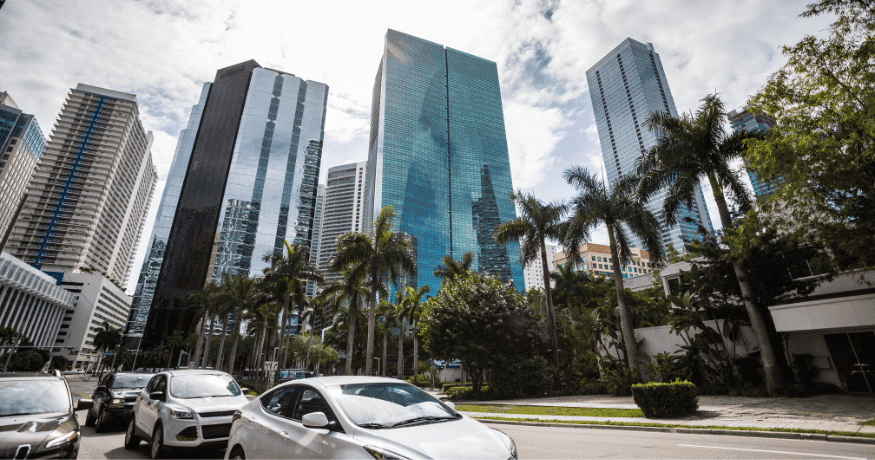As a researcher, I have been intrigued by the Miami real estate market trends for some time. Miami has established itself as a prime location for real estate investment because of its beaches, weather, food, and culture.
The recent pandemic has profoundly impacted the market, with many individuals seeking warm, low-tax, low-regulation cities like Miami for their next home.
This has led to an increase in demand, driving up housing prices. Additionally, foreign buyers, particularly from Latin America and Europe, have significantly shaped the market.
In this blog post, I aim to comprehensively examine the Miami real estate market, including the latest trends and statistics, as well as strategies for success in this competitive market.
I will also delve into the pandemic’s impact and foreign buyers’ role in the market. My goal is to provide readers with a thorough understanding of the Miami real estate market to enable informed decisions as real estate agents, investors, or anyone else interested in the Miami real estate market.
Understanding the Miami Real Estate Market Trends
The Miami real estate landscape is an ever-evolving mosaic of around 40 neighborhoods, each with its own distinct charm and viability for conventional rentals. For instance, it’s imperative to keep in mind that locations that are near businesses and employers where people commute to work are often sought after by renters who want to be close to their workplace.
Lately, the Miami real estate market has been booming, with the latest trends and statistics painting a picture of a thriving market. In 2021, for example, the Miami real estate market recorded a staggering 39,394 existing home sales, marking a 49.5% increase from the previous year.
Furthermore, the median property value in Miami has seen a considerable hike of 27.4% over the last year, affirming the high demand for housing in the region. The current median home value in Miami stands at an impressive $556,582, with a median list price of $549,667, signifying a yearly increase of 24.9%. The 27.4% 1-year appreciation rate and the optimistic 2.0% 1-year forecast serve as further evidence of a positive trend in the Miami real estate market.

The Miami real estate market is attractive to buyers and investors for several reasons. Firstly, the city is known for its beautiful beaches, great weather, and delicious food, making it desirable. Additionally, the city has an eclectic culture that can’t be found anywhere else. Foreign buyers are also attracted by the luxury lifestyle and the ability to invest in a stable economy.
The weeks of supply, new listings, active listings, homes sold, median days on the market, and median rent (1- & 2-bedroom units) are 25.2 and $2,050, respectively, indicating a balance between supply and demand in the market. Additionally, the price-to-rent ratio of 22.62 is considered favorable for potential renters and investors.
Furthermore, the Miami real estate market trend is supported by a robust local economy, with an unemployment rate of 2.3% and a median household income of $53,975. The population of Miami-Dade County is 2,662,77, providing a large pool of potential buyers and renters.
The total number of foreclosures in Miami is 3,327, which could be an opportunity for investors looking for a bargain. However, it’s important to research the properties and the area before making a purchase.
The pandemic is known to have had a significant impact on the Miami real estate market. The national migration to warm, low-tax, low-regulation cities like Miami is believed to have increased demand for housing and driven up prices.
Additionally, foreign buyers, particularly from Latin America and Europe, have significantly shaped the market.
This influx of buyers is believed to have put pressure on the market, leading to increased competition and higher prices. Overall, the Miami real estate market is an attractive option for agents and investors, with a strong economy and a high demand for housing.
However, staying informed about the latest trends and statistics is vital to make informed decisions in this ever-evolving market.
Miami Real Estate Market Trends 2022-2023

In April 2022, Miami real estate saw one of the highest total home sales months in history, coming in 7th place. According to the National Association of Realtors (NAR), the typical Florida home sale has an economic impact of $90,300.
In Miami-Dade County, 3,445 homes were sold, generating a local economic impact of $311 million. The total dollar volume for Miami was $2.8 billion for April. However, the dollar volume for single-family homes decreased by 28.53% compared to the previous year, going from $1.8 billion to $1.3 billion. Similarly, the dollar volume for condominiums decreased by 6.59% annually, from $1.7 billion to $1.5 billion.
The median price of a single-family home in Miami-Dade County saw an increase of 9.7% annually, rising from $515,000 to $565,000. Additionally, the median price of single-family homes in Miami has been growing for 125 consecutive months, setting a new record.
The median price of existing condominiums also saw a 20% increase annually, going from $325,000 to $390,000. The median price of condominiums has increased in 127 out of the last 131 months.
According to Realtor.com, in April 2022, the median listing home price in Miami-Dade County was $525K, showing a year-over-year increase of 19.6%. The median listing home price per square foot was $390, and the median home sold price was $480K.
Homes in Miami generally sold for around the asking price, with a sale-to-list price ratio of 100%. Ideally, buyers would prefer a percentage closer to 90%, while sellers would prefer a ratio of 100% or higher.
Strategies for Staying Ahead in the Miami Housing Market

The integration of Artificial Intelligence and data analytics in the real estate sector has become a critical factor in remaining at the forefront of the highly competitive market.
By utilizing powerful tools such as Phocas, which acts as a centralized hub for all business data, agents can effortlessly access, analyze, and comprehend the market, resulting in more informed decisions and more effective targeting of their audience.
Blogging also serves as a powerful tool for real estate agents seeking to connect with their target market.
By crafting articles that address the concerns of diverse buyers and sellers, such as newlyweds, first-time homeowners, retirees, and new parents in search of homes in quality school districts, agents can establish themselves as experts in their field and foster credibility with their audience.
In conclusion, it is imperative for agents to stay abreast of the overall trend in the market, possess an understanding of rental prices, and have knowledge about the availability of homes for sale. This empowers them to make informed decisions regarding pricing and marketing strategies.
Moreover, collaborating with a local realtor who possesses a deep understanding of the Miami real estate market can prove to be a valuable asset for agents who strive to succeed in the competitive market.
Local realtors can offer valuable insights into local neighborhoods, businesses, and schools, enabling agents to make the best decisions for their clients.
Additionally, being close to the beach or downtown can significantly increase the appeal of a property. Therefore, it is essential to keep location in mind when choosing a property to buy or rent in Miami.
The pandemic has influenced this trend, which has seen many people move to the state or purchase second homes. Another significant market component is foreign buyers. Agents and investors must be up-to-date on the most recent market trends and statistics to succeed in this cutthroat market.
This involves using data analytics and artificial intelligence tools to help you make better decisions and blogging to reach the correct audience. The property’s location should also be considered, as should dealing with a local broker who is well-versed in the Miami real estate market. We urge readers to use the methods this post covers to keep informed and take action.
You Can also read: Is Florida The Most Expensive State To Live In?




